Known worldwide as the oldest international sporting competition, The Americas Cup, affectionately known in the sailing community as the ‘Auld Mug’, is the biggest prize in the yachting world.
The first race was won in 1851 by The New York Yacht Club with their 101ft Schooner ‘America’. Commodore John Stevens of the NYYC had put together a 6-person team to build a yacht with hopes of making money competing in races in England. America raced against 15 yachts from the Royal Yacht Squadron in their annual 53-mile race around the Isle of Wight, coming in first place, 8 minutes ahead of the second finisher. Their prize was a trophy called the ‘£100 Cup’ (also known as ‘The 100 Guineas Cup’), subsequently renamed after the winning yacht, to the Americas Cup.
Queen Victoria, who was watching at the finish line, reportedly asked one of her attendants who was in second place, from which came the famous answer, "Ah, Your Majesty, there is no second.".
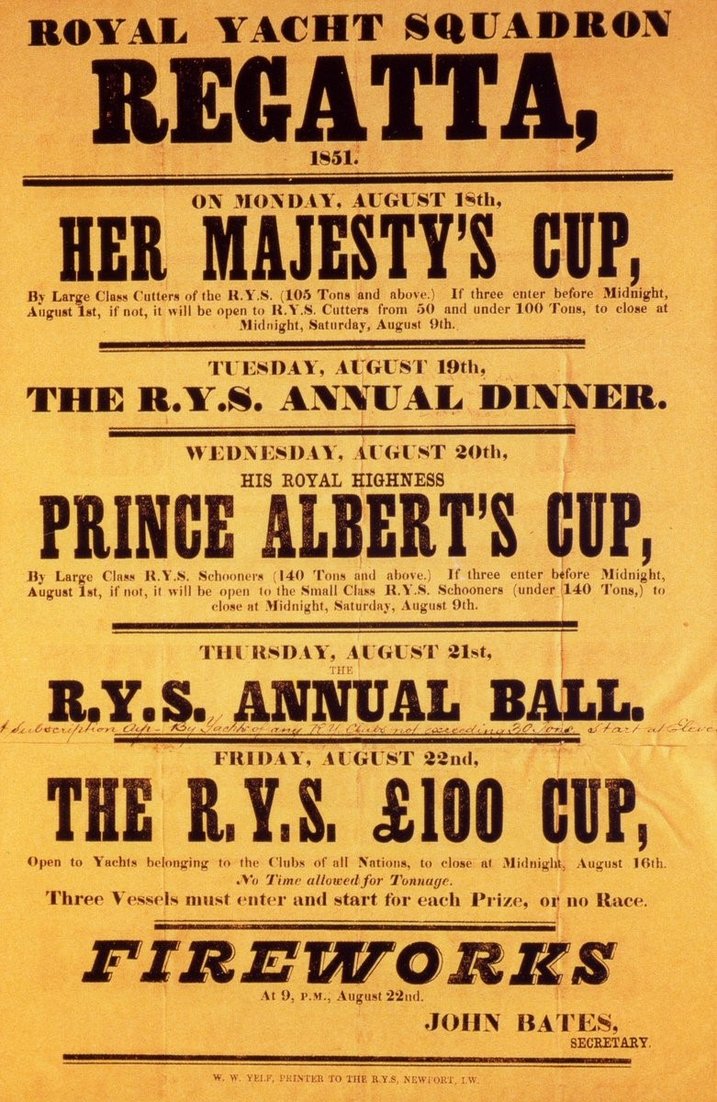
The poster advertising the £100 Cup
The first challenge against America came from British railway tycoon James Lloyd Ashbury in 1870, after his Topsail Schooner Cambria beat Americas ‘Sappho’ in a race on the Solent in 1968. Ashbury’s confidence was to no avail, as Cambria finished 10th in the 17-boat fleet.
Canada was the next to try and win away the trophy, they challenged twice but fell short of the mark on both attempts. Canadas second attempt was a disaster, the Canadian challenger ‘Atalanta’, representing the Bay of Quinte Yacht Club, was entered into the race despite being unfinished due to lack of funding. Such a spectacularly bad performance paved the way for the NYYC to change the deed of gift to accommodate new rules.
Deed of Gift - 1857
The Deed of Gift was a letter written to the secretary of the NYYC to formalize the rules that would govern the future of the Americas Cup. The deed of Gift originally stated that any foreign yacht club could challenge the current holder of the trophy, that the race would be held on the waters of the current holder, and that any challenger was to sail to the race destination on their own hull, so the boats could not be disassembled and rebuilt at the destination.
The deed of gift has been changed many times since the first race, rules such as the NYYC Rule (1885-87), put in place after Canadas failure, the rules were changed so that any challenger should belong to a yacht club based on an arm of the sea, which excluded any yacht clubs situated on the great lakes, and that any challenger accepted should sail to the venue on her own hull. They also imposed penalties on any challenger with a waterline longer than 85ft (25.91 m).
The Seawanhaka Rule (1889–1903) saw the waterline limit reduced to 70ft in 1889, although in the coming years this would increase to 85ft, and then 90ft. This rule led legendary yacht designer Nathanael Herreshoff to bend the rules by designing ‘Reliance’ the largest racing sloop ever built, described by some as a ‘racing freak’ due to her long overhangs, which ultimately increased her
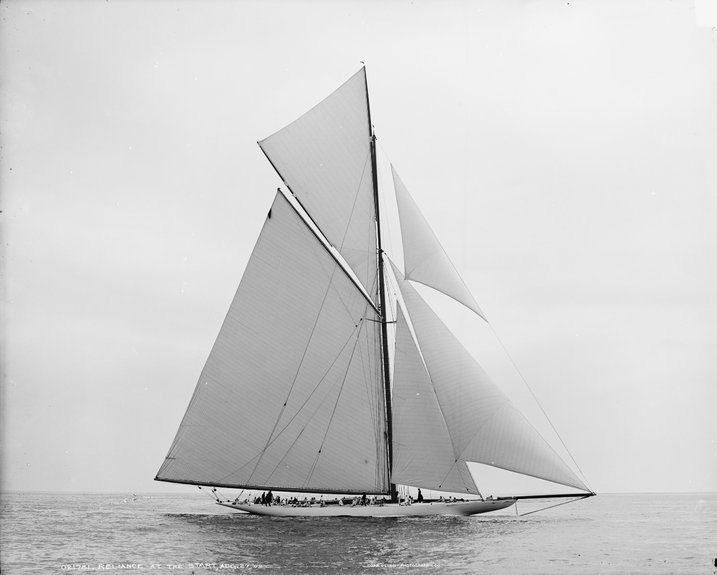
Nathanael Herreshoffs ‘Reliance’ - 1903 – Whilst her waterline was 90ft, her total length was 201ft
The Universal Rule (1914–1937) was introduced by Herreshoff, this rule determined that only J-Class yachts were eligible to race in the Americas Cup, single mast yachts between 65-76ft in length.
The Twelve-Metre Rule (1956–1987) was brought in after 21 years without a challenger, post-war economic realities meant that it was too expensive to build, maintain, and crew much larger vessels, so the 12-metre rule made way for smaller and more affordable boats.
In 1983, the Royal Sydney Yacht Squadron collaborated with Paul Madden of the NYYC to bring into play ‘The Challengers Cup’. Louis Vuitton was then contracted to be the sponsor of this cup, thus creating ‘The Louis Vuitton Cup’. This was to be the ‘decider’ race whose winner would go on to challenge the current holder of the Americas cup.
The New York Yacht Club held the trophy for an incredible 132 years, until they were challenged, and beaten by Australia in 1983 with a 63ft racing Yacht named ‘Australia II’. The nail-biting finale saw Australia II beat Americas defender ‘Liberty’ to the finish line breaking a 3-3 tie to win 4-3 on the 7th race. Australia’s secret weapon was a winged keel that they kept hidden from the competition under a ‘modesty skirt’ that was draped from the deck when the boat was being hauled from the water.
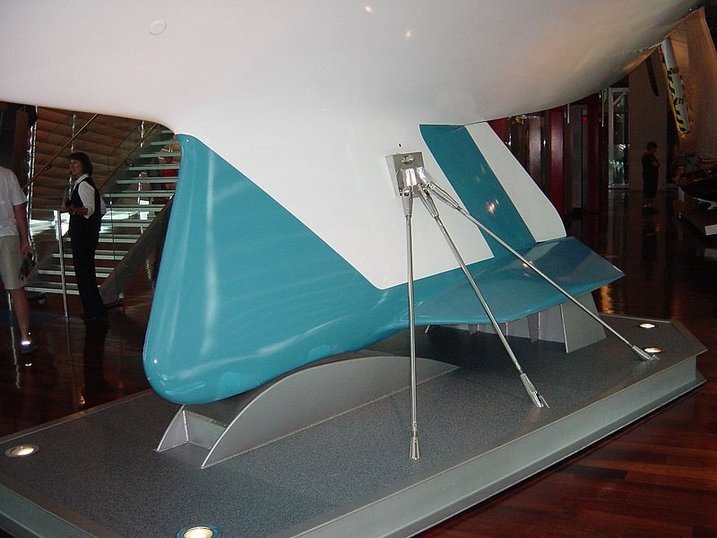
Australia’s secret weapon, the winged keel, designed by Ben Lexcen – Photo by Ctbolt, Wikipedia Commons
In 1987, the Americas cup was defended for the first time in the waters of Australia, off the coast of Fremantle, WA. Dennis Conner of the San Diego Yacht Club won the trophy back for the USA with his 12-metre challenge boat ‘Stars & Stripes 87’.
Soon after Conner had won back the Americas cup, New Zealander Sir Michael Fay of Mercury Bay Boating Club, surprised Conner by challenging with an enormous 90ft waterline yacht named ‘New Zealand (KZ1)’ or the ‘Big Boat’. Since the SDYC wanted to continue to race under the 12-metre rule, they contested this decision and took Fay to court, which ultimately saw the ‘Big Boat’ deemed eligible to race. With limited time to prepare for the race, the SDYC decided that a Catamaran was their best bet. With its lower mass and wing sail, the Catamaran, named after the last American winning boat ‘Stars & Stripes’, easily took the lead and America were declared the winners yet again.
Though this was not taken well by Fay, who considered the race unfair and thus took Conner back to court, winning the case and thus New Zealand were declared the winners by default. This decision was appealed and subsequently overturned and SDYC were once again declared to have successfully defended the cup, in what was described as the most controversial match since the cups inception.
After the controversy of the 1988 match, the International American Cup Class (IACC) Rule (1992-2007) came into play. The IACC yachts were to be designed to the same formula, but non-identical, so still giving the designers some free reign. The yachts were designed to be slightly longer than the 12-metre class but much lighter. The IACC yacht specs would be:
- LOA - 75’0”
- LWL - 57’0”
- Bea - 18’0”
- Draft - 13’0”
- Mast Height - 108’0”
- Sail Area
- (Main & jib) - 3,0002ft
- (Spinnaker) - 4,5002ft
In 1995, New Zealand took the cup in ‘NZL 32’, nicknamed "Black Magic" due to her jet-black hull. She challenged Dennis Conner’s defender yacht ‘Young America’ and sailed into an easy win beating Young America 5-0, making the 1995 Americas Cup New Zealand’s first official win.
On March 14th 1996 tragedy struck when Maori activist, Benjamin Peri Nathan, slipped past the security at Royal New Zealand Yacht Squadron's clubroom and attacked the Americas Cup trophy with a sledgehammer. He was subsequently convicted and jailed for 34 months. The cup was so badly damaged that it was feared to be irreparable. The New Zealand team who won the trophy reportedly tried to make light of the situation claiming "We heard we are going to be racing for the America's Plate now."
The original manufacturers of the cup, Garrards Silversmiths of London, spent 3 months slowly and carefully restoring the cup to its former glory.
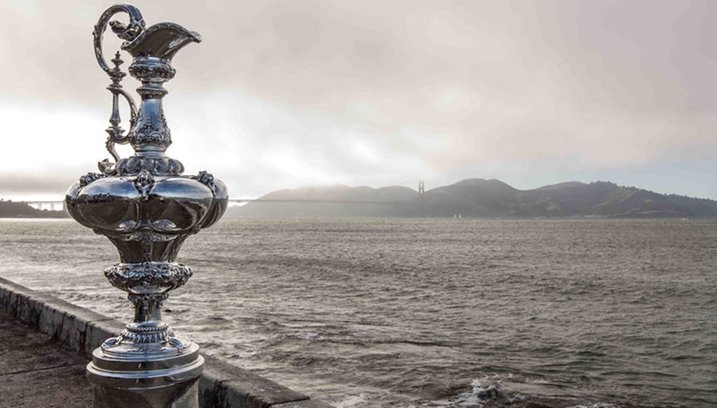
The Americas Cup Trophy, post-restoration
New Zealand went on to successfully defend the cup from the Italian challenger ‘Prada Challenge’ (AKA Luna Rossa) in 2000, this was the first Americas cup without an American challenger or defender.
Whilst holders of the cup, Team New Zealand went on to change the rules further, in 2003 they removed the rule that stated that all crew members be of the challenging teams nationality.
The Swiss team Société Nautique de Genève (SNG), took full advantage of this change and went on to hire some of the best and most experienced Americas Cup Sailors for their team ‘Alinghi’. This included many of the members of Team New Zealand, alongside sailors from countries such as the USA, Canada, the UK, Germany, Australia and South Africa to name a few.
Team Alinghi sailed to victory, winning 5-0 against New Zealand in the 2003 Americas Cup, this was a historical moment as it saw the Americas Cup trophy returned to Europe for the first time in 152 years.
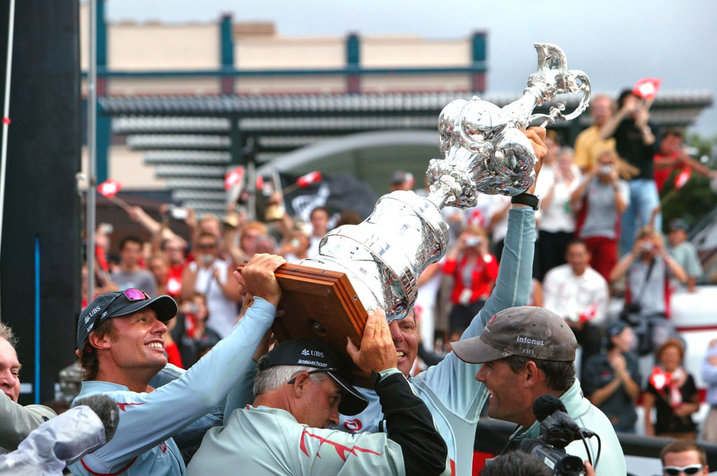
Swiss team Alinghi celebrating their 2003 win – Photo by Thierry Martinez
2007 saw Société Nautique de Genève amend the rules even further, leaving ‘constructed in country’ the only original rule concerning nationality. The 2007 Americas cup was held in Valencia, Spain, due to Switzerland not bordering an arm of the sea or the sea itself, this was the first time in the history of the Americas Cup that the race had been held in Europe, and also in a country other than the defenders own. Switzerland’s team Alinghi successfully defended the cup winning the match 5-2 against New Zealand challengers the ‘Royal New Zealand Yacht Squadron’.
After their win against team Alinghi, SNG accepted a challenge from Club Náutico Español de Vela (CNEV). After the protocol between the two yacht clubs was signed and made public, American club ‘Golden Gate Yacht Club’ (GGYC) filed their own challenge and also filed a court case claiming that CNEV were unqualified under the rules of the Deed of Gift and that they should be disqualified and GGYCs team ‘Oracle’ be named the official challenger. The court case filed by GGYC questioned the credentials of CNEV for reasons such as the fact that CNEV hadn't run an annual regatta on an open water course on the sea, or an arm of the sea, as required by the America's Cup's deed of gift. CNEV fought back but ultimately lost their case and GGYC were named the rightful challengers.
The match was set as a one-on-one, best-of-three race, Alinghi were unsuccessful in their defence and team ‘Oracle’ won 2-0 with their 113ft (LOA) trimaran ‘USA 17’.
2010 saw Italian yacht club Club Nautico di Roma (CNR) file a challenge against the current Americas Cup holders GGYC. The match was scheduled for 2013 and the protocol announced the AC72 class, an 86ft wing sail foiling catamaran, to be the competing boat style.
Also introduced were the AC45 class boats, 44ft one-design wing sail foiling catamarans that were based on a smaller scale version of the AC72s. These are known as the ‘training’ or ‘practice boats’ that were used in the America's Cup World Series, the pre-trials to determine the official challenger.
in May 2011, CNR withdrew from the competition due to financial struggles, following this decision the second team to file a challenge, the ‘Royal Swedish Yacht Club’ (RSYC) took their place.
The Royal New Zealand Yacht Club won their way to the challenger position by easily beating its swiss opponents RSYC in the Louis Vuitton cup and looked well on the way to taking the Americas Cup home once again.
For the cup match, USAs Team Oracle recruited England’s own Sir Ben Ainslie as their tactician. The match was decided to be a first-to-nine race, with the winners being the first team to score nine points, one point being awarded for each race won.
USAs team Oracle trailed behind New Zealand, at one point being only one point from failure as NZ lead 8-1, but Oracle came back from the brink with a phenomenal display, winning 8 straight races and sailing to victory with a 9-8 score.
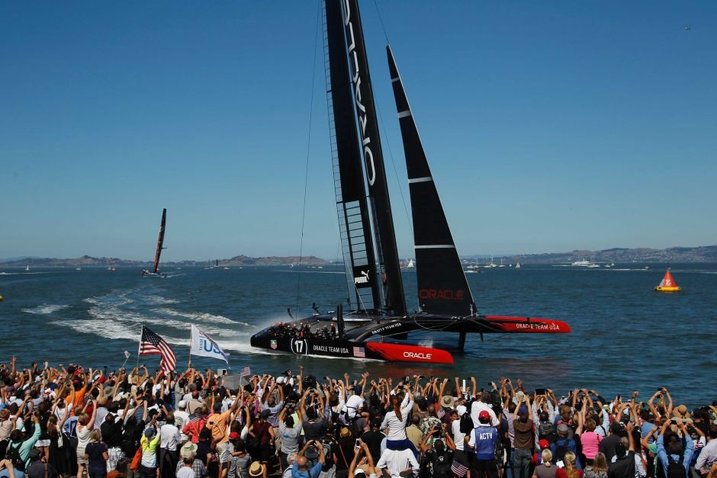
Team Oracle USA crossing the finish line –Photo Credit: Reuters, Stephen Lam
The Teams for the 35th America's Cup
In May 2017, the 35th Americas Cup will begin in Bermuda. The racing will start on 26th May with the Louis Vuitton Americas Cup Qualifiers.
5 teams will compete against the defender Oracle Team USA for the challenger position, the teams are:
- BMW Oracle Racing - USA (Defender & Current Cup Holder)
- Land Rover BAR - UK
- Emirates Team - New Zealand
- Softbank Team - Japan
- Groupama Team - France
- Artemis Racing - Sweden
All 6 teams will compete in 2 Round Robin between May 26th and June 3rd and the top 4 will advance to a best-of-9 semi-finals between June 6th-8th.
The winner of the semi-final will take the title of official challenger and race Team Oracle for the 2017 Americas Cup.
The Americas Cup final will be a best-of-13 race held between June 17th-27th 2017.
The Venue
The 35th Americas Cup will be held in the beautiful blue waters of Bermuda.